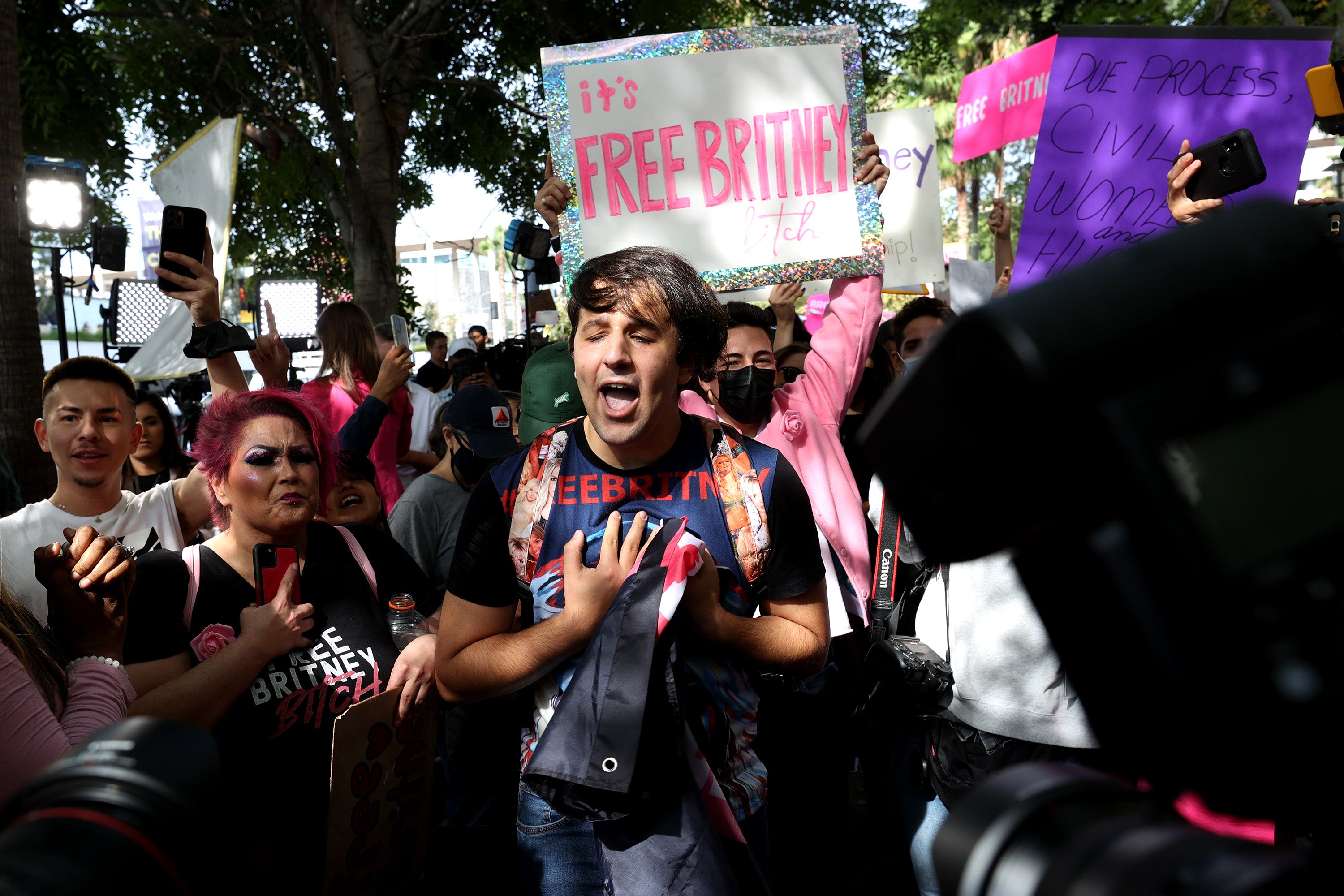#FreeBritney 2.0: Why Britney Spears became a lightning rod for internet conspiracy theories
A wave of online truthers believe Britney has been replaced by a body double with no bottom teeth. Katie Rosseinsky explores why TikTok sleuths have been on the rise since the star’s controversial conservatorship ended


At the peak of Britney Spears’ pop supremacy in the late Nineties and early Noughties, the singer’s megawatt grin was one of the most recognisable, photographed smiles in the world. Now, in certain corners of TikTok, it has become the subject of feverish speculation and mind-boggling theories. A subset of fans has begun to ask: is it, in fact, still the same smile? They place old red carpet photos of a teenage Britney alongside newer, grainier screen grabs from her Instagram account, honing in on a slight gap between her front teeth, even questioning whether she now has any bottom teeth at all.
Why the obsession with Britney’s teeth? And isn’t it quite normal for a smile to shift naturally over time, even if you’ve had some all-American orthodontia earlier in life? For the fans dissecting fuzzy photos of Britney’s “new” gums in quasi-forensic detail online, there’s another, much darker explanation. The change, they argue, is a glaring warning sign, proof that the Britney who we see dancing on Instagram is a fake. She might be a body double. She might be an AI creation – or perhaps a deepfake. The logistics are a little sketchy. But she definitely isn’t Britney Jean Spears, they claim, because the “real” Britney is elsewhere.
Welcome to the topsy-turvy world of #FreeBritney 2.0, where conspiracy theories about Spears’ whereabouts and wellbeing only seem to have intensified since the singer was released from her conservatorship in November 2021. For a faction of fans, it seems possible that the object of their devotion remains under some form of control. She could be in a hospital, some suggest, or in a mental health facility – so in her alleged absence, they theorise, her Instagram is being populated by videos and photos of a fake “Britney”.
There are other, conflicting hypotheses: that Britney is using her social platforms to send warning signs, making “SOS” signals as she dances. Or that puppet masters behind the scenes are allegedly sharing videos which are calculated to make the public question Britney’s state of mind (so that she can be placed under conservatorship again). Some make an even more disturbing claim: that she is no longer alive. The hashtag has shifted from #FreeBritney to #BritneyIsNotFree, #WhereIsBritney, or even #ItsBritneyGlitch, a nod to the iconic opening lines of her 2007 song “Gimme More”, one of the last singles she released pre-conservatorship.
Britney truthers assiduously scan her posts, identifying “glitches” which might suggest all is not well: distortion in her pictures, disappearing tattoos, eyes changing from brown (Britney’s colour) to blue. “It’s similar methods to what I see in QAnon, with very deep analysis, mining media artefacts, like videos, images, press releases, [to find] what is ‘really’ going on, rather than what is reported,” says Jack Wilson, a PhD researcher at the University of Warwick, whose work focuses on conspiracy theories, misinformation and populism.
This newer wave of theorists has even been branded “BAnon” by other sides of Britney’s fanbase. They speak authoritatively to the camera to impart their hidden knowledge, or use TikTok’s faintly creepy AI generated voice overs, telling us when a backdrop is “very obviously a green screen” or pointing out that “there is something very wrong with this picture” (to quote from a handful of popular posts).
It is all too easy to get drawn in: while researching this piece, I ended up playing and rewinding one particular clip, purporting to show a blink-and-you’ll-miss-it moment “proving” that Instagram Britney is just a blonde woman using a face filter, too many times to mention. “These videos are just naturally intriguing – if both the conspiratorial content itself is entertaining, and it’s also being delivered in this really engaging manner, it’s going to get your attention,” says Dr Daniel Jolley, an assistant professor in social psychology at the University of Nottingham, who specialises in the psychology of conspiracy theories.
Far-fetched theories about celebrities are nothing new. Think of the “Paul is dead” phenomenon, when Beatles fans became convinced that Paul McCartney had died in 1966 and been secretly replaced by a lookalike by MI5, to prevent Britain (and the world) from being swept up in paroxysms of collective grief. Or the “sightings” of Elvis Presley after his death, leading some devotees to believe that The King hadn’t left this mortal earth at all – he’d merely gone into hiding. Or, more recently, the bizarre suggestion that Avril Lavigne is not the angsty, baggy trouser-wearing star who released “Sk8er Boi” in 2002, because she has been replaced by a clone named Melissa.
There are myriad reasons why people fall down the conspiratorial rabbit hole. There’s what Jolley brands “the entertainment factor”, motivated by excitement and curiosity that might make you feel “like you’re part of a film or a TV show” rather than existing in a more tedious reality. There’s a feeling of community, of “working together to showcase a hidden plot”. Or there’s the potential for gaining clout online, boosting your own profile in the process. But when the focus of a conspiracy is a beloved famous person, there are other impulses at play too.
“It’s very much a case of fans wanting to keep their object of affection and adoration alive [in their minds], even if they’re killing them off in other ways, like ‘Paul is dead,’” explains Clare Birchall, professor of contemporary culture at King’s College London, whose research explores conspiracy theories, contested knowledge and digital culture. Conspiracies, she adds, can be “a way of keeping the conversation going” around an idol and continuing the narrative – “in that way, it’s not that different from fan fiction” – as well as a form of “showing your appreciation and care”.

To understand why pop’s former golden girl has become such a powerful magnet for dark speculation, we need to sift through her complicated and disturbing personal history. In February 2008, after a period of mental health issues documented in painstaking detail in the tabloid media, Britney was involuntarily placed under a temporary conservatorship. This court order initially put the control of her finances and day-to-day life in the hands of her father Jamie Spears and an attorney, Andrew Wallet. It was extended, then made permanent. Others, including Britney’s then-business manager Lou Taylor, were appointed as co-conservators.
The singer continued to work at a staggering rate, releasing albums, embarking on international tours and breaking records with her four-year Las Vegas residency. In fan forums, her admirers started to ask questions: how could Britney be considered well enough to pull off all-singing, all-dancing live shows, a mentally and physically draining feat for any performer, but simultaneously be unfit to make other important decisions? It was in 2019, when allegations emerged that Britney had been taken to a mental facility under duress, that the #FreeBritney movement really began to heat up.
Fans started combing through court documents, researching conservatorship laws in depth, organising real-life protests and examining the star’s emoji-laden social media posts for hidden messages. In 2020, one fan left a comment on her account, telling her: “If you need help wear yellow in your next video.” Days later, Britney posted a video, dressed in a yellow top. Shortly after, her father Jamie described the movement as “a joke”, telling the New York Post: “All these conspiracy theorists don’t know anything.”
The 2021 documentary Framing Britney Spears helped #FreeBritney gain momentum, placing the conservatorship in the spotlight and interviewing campaigners. In June 2021, Britney gave an extraordinary, emotionally charged statement to a Los Angeles court. She claimed that she had been forced to attend a mental facility against her will, been put on the drug lithium, and prevented from getting her IUD removed so that she could try to get pregnant (Jamie later denied that he had involvement in his daughter’s “personal affairs”). “I am traumatised,” she said. When the conservatorship was finally dissolved that November, it was hailed as a victory for the grassroots campaign. “I honestly think you guys saved my life in a way,” Britney told her fans in an Instagram post later that month.
For most conspiracy theories, there is some legitimate core
What had initially been dismissed as a fringe conspiracy went on to have major implications in the real world. But for some fans, it seems, the process of digging deeper for some form of hidden “truth” has proven addictive, with the success of #FreeBritney 1.0 “offer[ing] some kind of credence” to their new theories, as Dr Jolley puts it: last time, their concerns turned out to be legitimate, after all. “For most conspiracy theories, there is some legitimate core,” Professor Birchall says. “Even something as seemingly off the wall as QAnon has a root distrust of what they call the ‘deep state’. We’ve been through more than 30 years of neoliberal ideology, which tells you that there is no such thing as society… promoting a small state, all of that. So it’s not really surprising that we have a plethora of deep state conspiracy theories.”
Dr Ed Katrak Spencer is a postdoctoral research associate at the University of Manchester who is currently researching online conspiracies about Britney’s one-time Pepsi ad co-star, Beyoncé (like the bizarre episode in 2020 when a Florida politician claimed that Bey was actually an Italian woman named Ann Marie Lastrassi?). Often, he suggests, conspiracies are “cultural critique gone askew”. In this case, these theories might stem from a “struggle to come to terms with the dark side of the music industry”, and the damage that might wreak on a woman like Britney. “In a way, it’s a mirroring of the trauma that Britney Spears herself experienced for years and years – it’s this collective, distributed trauma among fans … like a sort of echo effect,” he adds. The sad irony is that this “echo” might just exacerbate the “feeding frenzy” that still surrounds Spears. For proof, we only have to look back at two instances this year, when her fans called the police to her home, citing concerns for her wellbeing. “I love and adore my fans but this time things went a little too far and my privacy was invaded,” she wrote in the aftermath of one of those incidents in January.
Even a theory as overblown as, say, suggesting Britney has been replaced with a lookalike with substandard dental work is rooted in a simple, affecting truth: fans want to think that they “know” the real Britney, the woman whose talent and beauty has shaped their lives, and to believe that “their” Britney would not behave or look a certain way. “Often, people seem to actually want the glamorous artifice of Britney Spears over the reality of post-conservatorship Britney Spears,” Spencer says. For them, he explains, “the authentic Britney is actually the glossy, stylised, carefully managed one.” The tragedy of the Britney conspiracy industrial complex is that we just can’t seem to accept the real person in front of us: a woman with complicated mental health issues, who doesn’t always appear in front of her phone camera with red-carpet-ready hair and make-up.

The idea of “recycling damage” is endlessly popular in the music industry, Spencer explains. Just look at the way Miley Cyrus and Shakira have turned their marital breakdowns into revenge bangers, or how Kesha has responded to her traumatic past in her most recent album, Gag Order, its title alluding to her legal battle with producer Dr Luke (the pair reached a settlement in June). We want to see stars bounce back from hardship bigger and better, “stronger than yesterday”, to borrow a lyric from Britney’s back catalogue. “So in a way, you could say that at the end of the conservatorship, for some people looking on, Britney Spears was not actually quick enough to recycle all of that suffering and damage that she endured through that classic formula of ‘look, I overcame,’” Spencer says.
Britney has deviated from that formula – hence the slew of increasingly wild theories attempting to account for why that might be. Jack Wilson agrees. “I think they’re trying to make sense of why Britney isn’t doing what they expected her to do after the conservatorship, so they’re trying to rationalise why things haven’t quite turned out how they expected,” he says. “It’s a lot easier to say that ‘Britney still isn’t free’ or that there’s some other things afoot, than to [recognise that] this is a complex situation [for] a complex person that they don’t have access to.”
“I think a lot of people expected with the conservatorship [ending], it would be a happily ever after,” he adds. The reality is much more complicated. Everyone still wants a piece of Britney – but spreading conspiracies, however well-intentioned they might be, surely just risks continuing her exploitation for entertainment.
Join our commenting forum
Join thought-provoking conversations, follow other Independent readers and see their replies
Comments


Bookmark popover
Removed from bookmarks